Target Information
| Target General Information | Top | |||||
|---|---|---|---|---|---|---|
| Target ID |
T85943
(Former ID: TTDS00247)
|
|||||
| Target Name |
Proto-oncogene c-Src (SRC)
|
|||||
| Synonyms |
pp60c-src; Tyrosine kinase (pp60(src)); Src tyrosine kinase; SRC1; Proto-oncogene tyrosine-protein kinase Src; Pp60(src); P60-Src; C-src TK; C-Src
Click to Show/Hide
|
|||||
| Gene Name |
SRC
|
|||||
| Target Type |
Successful target
|
[1] | ||||
| Disease | [+] 4 Target-related Diseases | + | ||||
| 1 | Breast cancer [ICD-11: 2C60-2C6Y] | |||||
| 2 | Ischemia [ICD-11: 8B10-8B11] | |||||
| 3 | Myeloproliferative neoplasm [ICD-11: 2A20] | |||||
| 4 | Solid tumour/cancer [ICD-11: 2A00-2F9Z] | |||||
| Function |
Participates in signaling pathways that control a diverse spectrum of biological activities including gene transcription, immune response, cell adhesion, cell cycle progression, apoptosis, migration, and transformation. Due to functional redundancy between members of the SRC kinase family, identification of the specific role of each SRC kinase is very difficult. SRC appears to be one of the primary kinases activated following engagement of receptors and plays a role in the activation of other protein tyrosine kinase (PTK) families. Receptor clustering or dimerization leads to recruitment of SRC to the receptor complexes where it phosphorylates the tyrosine residues within the receptor cytoplasmic domains. Plays an important role in the regulation of cytoskeletal organization through phosphorylation of specific substrates such as AFAP1. Phosphorylation of AFAP1 allows the SRC SH2 domain to bind AFAP1 and to localize to actin filaments. Cytoskeletal reorganization is also controlled through the phosphorylation of cortactin (CTTN). When cells adhere via focal adhesions to the extracellular matrix, signals are transmitted by integrins into the cell resulting in tyrosine phosphorylation of a number of focal adhesion proteins, including PTK2/FAK1 and paxillin (PXN). In addition to phosphorylating focal adhesion proteins, SRC is also active at the sites of cell-cell contact adherens junctions and phosphorylates substrates such as beta-catenin (CTNNB1), delta-catenin (CTNND1), and plakoglobin (JUP). Another type of cell-cell junction, the gap junction, is also a target for SRC, which phosphorylates connexin-43 (GJA1). SRC is implicated in regulation of pre-mRNA-processing and phosphorylates RNA-binding proteins such as KHDRBS1. Also plays a role in PDGF-mediated tyrosine phosphorylation of both STAT1 and STAT3, leading to increased DNA binding activity of these transcription factors. Involved in the RAS pathway through phosphorylation of RASA1 and RASGRF1. Plays a role in EGF-mediated calcium-activated chloride channel activation. Required for epidermal growth factor receptor (EGFR) internalization through phosphorylation of clathrin heavy chain (CLTC and CLTCL1) at 'Tyr-1477'. Involved in beta-arrestin (ARRB1 and ARRB2) desensitization through phosphorylation and activation of GRK2, leading to beta-arrestin phosphorylation and internalization. Has a critical role in the stimulation of the CDK20/MAPK3 mitogen-activated protein kinase cascade by epidermal growth factor. Might be involved not only in mediating the transduction of mitogenic signals at the level of the plasma membrane but also in controlling progression through the cell cycle via interaction with regulatory proteins in the nucleus. Plays an important role in osteoclastic bone resorption in conjunction with PTK2B/PYK2. Both the formation of a SRC-PTK2B/PYK2 complex and SRC kinase activity are necessary for this function. Recruited to activated integrins by PTK2B/PYK2, thereby phosphorylating CBL, which in turn induces the activation and recruitment of phosphatidylinositol 3-kinase to the cell membrane in a signaling pathway that is critical for osteoclast function. Promotes energy production in osteoclasts by activating mitochondrial cytochrome C oxidase. Phosphorylates DDR2 on tyrosine residues, thereby promoting its subsequent autophosphorylation. Phosphorylates RUNX3 and COX2 on tyrosine residues, TNK2 on 'Tyr-284' and CBL on 'Tyr-731'. Enhances DDX58/RIG-I-elicited antiviral signaling. Phosphorylates PDPK1 at 'Tyr-9', 'Tyr-373' and 'Tyr-376'. Phosphorylates BCAR1 at 'Tyr-128'. Phosphorylates CBLC at multiple tyrosine residues, phosphorylation at 'Tyr-341' activates CBLC E3 activity. Involved in anchorage-independent cell growth. Required for podosome formation. Non-receptor protein tyrosine kinase which is activated following engagement of many different classes of cellular receptors including immune response receptors, integrins and other adhesion receptors, receptor protein tyrosine kinases, G protein-coupled receptors as well as cytokine receptors.
Click to Show/Hide
|
|||||
| BioChemical Class |
Kinase
|
|||||
| UniProt ID | ||||||
| EC Number |
EC 2.7.10.2
|
|||||
| Sequence |
MGSNKSKPKDASQRRRSLEPAENVHGAGGGAFPASQTPSKPASADGHRGPSAAFAPAAAE
PKLFGGFNSSDTVTSPQRAGPLAGGVTTFVALYDYESRTETDLSFKKGERLQIVNNTEGD WWLAHSLSTGQTGYIPSNYVAPSDSIQAEEWYFGKITRRESERLLLNAENPRGTFLVRES ETTKGAYCLSVSDFDNAKGLNVKHYKIRKLDSGGFYITSRTQFNSLQQLVAYYSKHADGL CHRLTTVCPTSKPQTQGLAKDAWEIPRESLRLEVKLGQGCFGEVWMGTWNGTTRVAIKTL KPGTMSPEAFLQEAQVMKKLRHEKLVQLYAVVSEEPIYIVTEYMSKGSLLDFLKGETGKY LRLPQLVDMAAQIASGMAYVERMNYVHRDLRAANILVGENLVCKVADFGLARLIEDNEYT ARQGAKFPIKWTAPEAALYGRFTIKSDVWSFGILLTELTTKGRVPYPGMVNREVLDQVER GYRMPCPPECPESLHDLMCQCWRKEPEERPTFEYLQAFLEDYFTSTEPQYQPGENL Click to Show/Hide
|
|||||
| 3D Structure | Click to Show 3D Structure of This Target | PDB | ||||
| ADReCS ID | BADD_A04520 | |||||
| HIT2.0 ID | T45G32 | |||||
| Drugs and Modes of Action | Top | |||||
|---|---|---|---|---|---|---|
| Approved Drug(s) | [+] 4 Approved Drugs | + | ||||
| 1 | Bosutinib | Drug Info | Approved | Breast cancer | [2], [3] | |
| 2 | Dasatinib | Drug Info | Approved | Chronic myelogenous leukaemia | [4], [5], [6], [7] | |
| 3 | Herbimycin A | Drug Info | Approved | Solid tumour/cancer | [8], [1] | |
| 4 | SKI-758 | Drug Info | Approved | Ischemia | [9], [7] | |
| Clinical Trial Drug(s) | [+] 11 Clinical Trial Drugs | + | ||||
| 1 | AL3818 | Drug Info | Phase 3 | Alveolar soft part sarcoma | [10] | |
| 2 | CP-868596 | Drug Info | Phase 3 | Gastrointestinal cancer | [11], [12] | |
| 3 | KX-01 | Drug Info | Phase 3 | Actinic keratosis | [13] | |
| 4 | Masitinib | Drug Info | Phase 3 | Amyotrophic lateral sclerosis | [14] | |
| 5 | Saracatinib | Drug Info | Phase 2 | Solid tumour/cancer | [15], [16] | |
| 6 | TPX-0046 | Drug Info | Phase 1/2 | Solid tumour/cancer | [17] | |
| 7 | ISIS-CRP | Drug Info | Phase 1 | Inflammation | [18] | |
| 8 | KX2-361 | Drug Info | Phase 1 | Brain cancer | [19] | |
| 9 | PUR1800 | Drug Info | Phase 1 | Chronic obstructive pulmonary disease | [20] | |
| 10 | SUN-K0706 | Drug Info | Phase 1 | Chronic lymphocytic leukaemia | [10] | |
| 11 | TPX-0022 | Drug Info | Phase 1 | Solid tumour/cancer | [21] | |
| Discontinued Drug(s) | [+] 1 Discontinued Drugs | + | ||||
| 1 | AP22408 | Drug Info | Terminated | Osteoporosis | [22] | |
| Mode of Action | [+] 2 Modes of Action | + | ||||
| Inhibitor | [+] 123 Inhibitor drugs | + | ||||
| 1 | Bosutinib | Drug Info | [23] | |||
| 2 | Dasatinib | Drug Info | [23], [24], [25] | |||
| 3 | Herbimycin A | Drug Info | [1] | |||
| 4 | SKI-758 | Drug Info | [26] | |||
| 5 | AL3818 | Drug Info | [10] | |||
| 6 | CP-868596 | Drug Info | [10] | |||
| 7 | KX-01 | Drug Info | [13] | |||
| 8 | Masitinib | Drug Info | [27] | |||
| 9 | TPX-0046 | Drug Info | [29] | |||
| 10 | ISIS-CRP | Drug Info | [30] | |||
| 11 | KX2-361 | Drug Info | [31] | |||
| 12 | PUR1800 | Drug Info | [32] | |||
| 13 | SUN-K0706 | Drug Info | [10], [33] | |||
| 14 | TPX-0022 | Drug Info | [34] | |||
| 15 | Aromatic bicyclic compound 1 | Drug Info | [35] | |||
| 16 | Aromatic bicyclic compound 2 | Drug Info | [35] | |||
| 17 | Aromatic bicyclic compound 3 | Drug Info | [35] | |||
| 18 | Aromatic bicyclic compound 4 | Drug Info | [35] | |||
| 19 | Aromatic bicyclic compound 5 | Drug Info | [35] | |||
| 20 | Aromatic bicyclic compound 6 | Drug Info | [35] | |||
| 21 | Deuterated 3-cyanoquinoline derivative 1 | Drug Info | [36] | |||
| 22 | PMID28460551-Compound-6 | Drug Info | [37] | |||
| 23 | Pyridine derivative 18 | Drug Info | [38] | |||
| 24 | AP22408 | Drug Info | [39] | |||
| 25 | PD166285 | Drug Info | [40] | |||
| 26 | 2-(4-CARCOXY-5-ISOPROPYLTHIAZOLYL)BENZOPIPERIDINE | Drug Info | [41] | |||
| 27 | 3-(3-aminobenzo[e][1,2,4]triazin-7-yl)phenol | Drug Info | [42] | |||
| 28 | 4-Chloro-5,7-diphenyl-7H-pyrrolo[2,3-d]pyrimidine | Drug Info | [43] | |||
| 29 | 5,7-Diphenyl-7H-pyrrolo[2,3-d]pyrimidin-4-ol | Drug Info | [43] | |||
| 30 | 7-(naphthalen-2-yl)benzo[e][1,2,4]triazin-3-amine | Drug Info | [42] | |||
| 31 | A-420983 | Drug Info | [44] | |||
| 32 | A-770041 | Drug Info | [45] | |||
| 33 | Ac-Cys-Ile-cyclo[Phe-Lys]-Tyr-Tyr | Drug Info | [46] | |||
| 34 | Ac-Cys-Ile-Phe(4-NO2)-Lys-Phe(4-NO2)-Tyr | Drug Info | [46] | |||
| 35 | Ac-Cys-Ile-Phe(4-NO2)-Lys-Tyr-Phe(4-NO2) | Drug Info | [46] | |||
| 36 | Ac-Cys-Ile-Phe(4-NO2)-Lys-Tyr-Tyr | Drug Info | [46] | |||
| 37 | Ac-Cys-Ile-Tyr-Lys-Phe(4-Cl)-Tyr | Drug Info | [46] | |||
| 38 | Ac-Cys-Ile-Tyr-Lys-Phe(4-CN)-Tyr | Drug Info | [46] | |||
| 39 | Ac-Cys-Ile-Tyr-Lys-Phe(4-I)-Tyr | Drug Info | [46] | |||
| 40 | Ac-Cys-Ile-Tyr-Lys-Phe(4-N3)-Tyr | Drug Info | [46] | |||
| 41 | Ac-Cys-Ile-Tyr-Lys-Phe(4-NO2)-Phe(4-NO2) | Drug Info | [46] | |||
| 42 | Ac-Cys-Ile-Tyr-Lys-Phe(4-NO2)-Tyr-Phe | Drug Info | [46] | |||
| 43 | Ac-Cys-Ile-Tyr-Lys-Tyr-Phe(4-NO2) | Drug Info | [46] | |||
| 44 | AP-24163 | Drug Info | [47] | |||
| 45 | AP-24226 | Drug Info | [47] | |||
| 46 | BAS-00387275 | Drug Info | [48] | |||
| 47 | BAS-00387328 | Drug Info | [48] | |||
| 48 | BAS-00387347 | Drug Info | [48] | |||
| 49 | BAS-00672722 | Drug Info | [48] | |||
| 50 | BAS-01047341 | Drug Info | [48] | |||
| 51 | BAS-01047655 | Drug Info | [48] | |||
| 52 | BAS-01373578 | Drug Info | [48] | |||
| 53 | BAS-0338868 | Drug Info | [49] | |||
| 54 | BAS-0338872 | Drug Info | [49] | |||
| 55 | BAS-09534324 | Drug Info | [48] | |||
| 56 | BAS-450225 | Drug Info | [48] | |||
| 57 | BAS-4844343 | Drug Info | [48] | |||
| 58 | BMS-279700 | Drug Info | [50] | |||
| 59 | CGP 77675 | Drug Info | [51] | |||
| 60 | CGP-191 | Drug Info | [43] | |||
| 61 | CGP-62464 | Drug Info | [43] | |||
| 62 | Cyclo[Ac-Cys-Ile-Phe]-Lys-Tyr-Tyr | Drug Info | [46] | |||
| 63 | Cyclo[Ac-Cys-Ile-Tyr-Lys-Tyr-Phe] | Drug Info | [46] | |||
| 64 | Cyclo[Ac-Cys-Ile-Tyr-Lys-Tyr-Tyr] | Drug Info | [46] | |||
| 65 | Cysteine Sulfenic Acid | Drug Info | [52] | |||
| 66 | DPI59 | Drug Info | [41] | |||
| 67 | Glu-Pro-Gln-F2Pmp-Glu-Glu-Ile-Pro-Ile-Tyr-Leu | Drug Info | [53] | |||
| 68 | Glu-Pro-Gln-pTyr-Glu-Glu-Ile-Pro-Ile-Tyr-Leu | Drug Info | [53] | |||
| 69 | HKI-9924129 | Drug Info | [54] | |||
| 70 | ISO24 | Drug Info | [41] | |||
| 71 | JNJ-10198409 | Drug Info | [55] | |||
| 72 | K00244 | Drug Info | [56] | |||
| 73 | N-(4-(phenylamino)quinazolin-6-yl)acrylamide | Drug Info | [41] | |||
| 74 | N-Phenyl-5-phenylimidazo[1,5-a]pyrazin-8-amine | Drug Info | [50] | |||
| 75 | N6-Benzyl Adenosine-5'-Diphosphate | Drug Info | [57] | |||
| 76 | NG-25 | Drug Info | [58] | |||
| 77 | NM-PP1 | Drug Info | [30] | |||
| 78 | Oxalic Acid | Drug Info | [57] | |||
| 79 | PAS219 | Drug Info | [41] | |||
| 80 | PASBN | Drug Info | [41] | |||
| 81 | PD-0166326 | Drug Info | [59] | |||
| 82 | PD-0173952 | Drug Info | [54] | |||
| 83 | PD-0173955 | Drug Info | [54] | |||
| 84 | PD-0173956 | Drug Info | [59] | |||
| 85 | PD-0173958 | Drug Info | [54] | |||
| 86 | PD-0179483 | Drug Info | [54] | |||
| 87 | PD-174265 | Drug Info | [60] | |||
| 88 | PD173074 | Drug Info | [40] | |||
| 89 | Phenylphosphate | Drug Info | [52] | |||
| 90 | Phosphonotyrosine | Drug Info | [57] | |||
| 91 | PMID15546730C2 | Drug Info | [61] | |||
| 92 | PMID22765894C8h | Drug Info | [62] | |||
| 93 | PP121 | Drug Info | [63] | |||
| 94 | RU78191 | Drug Info | [41] | |||
| 95 | RU78262 | Drug Info | [41] | |||
| 96 | RU78299 | Drug Info | [41] | |||
| 97 | RU78300 | Drug Info | [41] | |||
| 98 | RU78783 | Drug Info | [57] | |||
| 99 | RU79072 | Drug Info | [41] | |||
| 100 | RU79073 | Drug Info | [41] | |||
| 101 | RU79256 | Drug Info | [41] | |||
| 102 | RU81843 | Drug Info | [57] | |||
| 103 | RU82129 | Drug Info | [57] | |||
| 104 | RU82197 | Drug Info | [52] | |||
| 105 | RU82209 | Drug Info | [57] | |||
| 106 | RU83876 | Drug Info | [57] | |||
| 107 | RU84687 | Drug Info | [41] | |||
| 108 | RU85053 | Drug Info | [57] | |||
| 109 | RU85493 | Drug Info | [57] | |||
| 110 | RU90395 | Drug Info | [57] | |||
| 111 | SBB007833 | Drug Info | [64] | |||
| 112 | SKS-927 | Drug Info | [65] | |||
| 113 | SU 6656 | Drug Info | [30] | |||
| 114 | TG-100435 | Drug Info | [66] | |||
| 115 | WH-4-023 | Drug Info | [67] | |||
| 116 | Y-c[D-Pen-(2')Nal-GSFC]KR-NH2 | Drug Info | [68] | |||
| 117 | Y-c[D-Pen-(2R,3R)-2-Me-(2')Nal-GSFC]KR-NH2 | Drug Info | [68] | |||
| 118 | Y-c[D-Pen-(2R,3S)-2-Me-(2')Nal-GSFC]KR-NH2 | Drug Info | [68] | |||
| 119 | Y-c[D-Pen-(2S,3R)-2-Me-(2')Nal-GSFC]KR-NH2 | Drug Info | [68] | |||
| 120 | Y-c[D-Pen-(2S,3S)-2-Me-(2')Nal-GSFC]KR-NH2 | Drug Info | [68] | |||
| 121 | Y-c[D-Pen-(3,5-diI)Tyr-GSFC]KR-NH2 | Drug Info | [68] | |||
| 122 | Y-c[D-Pen-(3-I)Tyr-GSFC]KR-NH2 | Drug Info | [68] | |||
| 123 | Y-c[D-Pen-D-(2')Nal-GSFC]KR-NH2 | Drug Info | [68] | |||
| Modulator | [+] 1 Modulator drugs | + | ||||
| 1 | Saracatinib | Drug Info | [28] | |||
| Cell-based Target Expression Variations | Top | |||||
|---|---|---|---|---|---|---|
| Cell-based Target Expression Variations | ||||||
| Drug Binding Sites of Target | Top | |||||
|---|---|---|---|---|---|---|
| Ligand Name: Ponatinib | Ligand Info | |||||
| Structure Description | Src Kinase Domain in complex with ponatinib | PDB:7OTE | ||||
| Method | X-ray diffraction | Resolution | 2.49 Å | Mutation | No | [69] |
| PDB Sequence |
DAWEIPRESL
270 RLEVKLGQGC280 FGEVWMGTWN290 GTTRVAIKTL300 KPGTMSPEAF310 LQEAQVMKKL 320 RHEKLVQLYA330 VVSEEPIYIV340 TEYMSKGSLL350 DFLKGETGKY360 LRLPQLVDMA 370 AQIASGMAYV380 ERMNYVHRDL390 RAANILVGEN400 LVCKVADFGF427 PIKWTAPEAA 437 LYGRFTIKSD447 VWSFGILLTE457 LTTKGRVPYP467 GMVNREVLDQ477 VERGYRMPCP 487 PECPESLHDL497 MCQCWRKEPE507 ERPTFEYLQA517 FLEDYFTSTE527 PQYQPGENL |
|||||
|
|
LEU276
4.407
VAL284
3.832
ALA296
3.583
ILE297
3.574
LYS298
2.467
GLU313
2.929
VAL316
3.974
MET317
3.480
LEU320
4.323
LEU325
3.144
VAL326
3.912
ILE339
4.175
THR341
3.308
GLU342
3.638
TYR343
3.405
|
|||||
| Ligand Name: Bosutinib | Ligand Info | |||||
| Structure Description | human Src kinase bound to kinase inhibitor bosutinib | PDB:4MXO | ||||
| Method | X-ray diffraction | Resolution | 2.10 Å | Mutation | No | [70] |
| PDB Sequence |
KDAWEIPRES
266 LRLEVKLGQG276 CFGEVWMGTW286 NGTTRVAIKT296 LKPGTMSPEA306 FLQEAQVMKK 316 LRHEKLVQLY326 AVVSEEPIYI336 VTEYMSKGSL346 LDFLKGETGK356 YLRLPQLVDM 366 AAQIASGMAY376 VERMNYVHRD386 LRAANILVGE396 NLVCKVADFG406 LARLIEFPIK 427 WTAPEAALYG437 RFTIKSDVWS447 FGILLTELTT457 KGRVPYPGMV467 NREVLDQVER 477 GYRMPCPPEC487 PESLHDLMCQ497 CWRKEPEERP507 TFEYLQAFLE517 DYFTSTEPQY 527 QPGENL
|
|||||
|
|
LEU273
3.454
GLY274
4.949
VAL281
3.911
ALA293
3.007
ILE294
3.566
LYS295
3.284
GLU310
3.278
MET314
3.364
VAL323
3.475
ILE336
3.441
VAL337
4.286
|
|||||
| Click to View More Binding Site Information of This Target and Ligand Pair | ||||||
| Click to View More Binding Site Information of This Target with Different Ligands | ||||||
| Different Human System Profiles of Target | Top |
|---|---|
|
Human Similarity Proteins
of target is determined by comparing the sequence similarity of all human proteins with the target based on BLAST. The similarity proteins for a target are defined as the proteins with E-value < 0.005 and outside the protein families of the target.
A target that has fewer human similarity proteins outside its family is commonly regarded to possess a greater capacity to avoid undesired interactions and thus increase the possibility of finding successful drugs
(Brief Bioinform, 21: 649-662, 2020).
Human Tissue Distribution
of target is determined from a proteomics study that quantified more than 12,000 genes across 32 normal human tissues. Tissue Specificity (TS) score was used to define the enrichment of target across tissues.
The distribution of targets among different tissues or organs need to be taken into consideration when assessing the target druggability, as it is generally accepted that the wider the target distribution, the greater the concern over potential adverse effects
(Nat Rev Drug Discov, 20: 64-81, 2021).
Human Pathway Affiliation
of target is determined by the life-essential pathways provided on KEGG database. The target-affiliated pathways were defined based on the following two criteria (a) the pathways of the studied target should be life-essential for both healthy individuals and patients, and (b) the studied target should occupy an upstream position in the pathways and therefore had the ability to regulate biological function.
Targets involved in a fewer pathways have greater likelihood to be successfully developed, while those associated with more human pathways increase the chance of undesirable interferences with other human processes
(Pharmacol Rev, 58: 259-279, 2006).
Biological Network Descriptors
of target is determined based on a human protein-protein interactions (PPI) network consisting of 9,309 proteins and 52,713 PPIs, which were with a high confidence score of ≥ 0.95 collected from STRING database.
The network properties of targets based on protein-protein interactions (PPIs) have been widely adopted for the assessment of target’s druggability. Proteins with high node degree tend to have a high impact on network function through multiple interactions, while proteins with high betweenness centrality are regarded to be central for communication in interaction networks and regulate the flow of signaling information
(Front Pharmacol, 9, 1245, 2018;
Curr Opin Struct Biol. 44:134-142, 2017).
Human Similarity Proteins
Human Tissue Distribution
Human Pathway Affiliation
Biological Network Descriptors
|
|
|
Note:
If a protein has TS (tissue specficity) scores at least in one tissue >= 2.5, this protein is called tissue-enriched (including tissue-enriched-but-not-specific and tissue-specific). In the plots, the vertical lines are at thresholds 2.5 and 4.
|


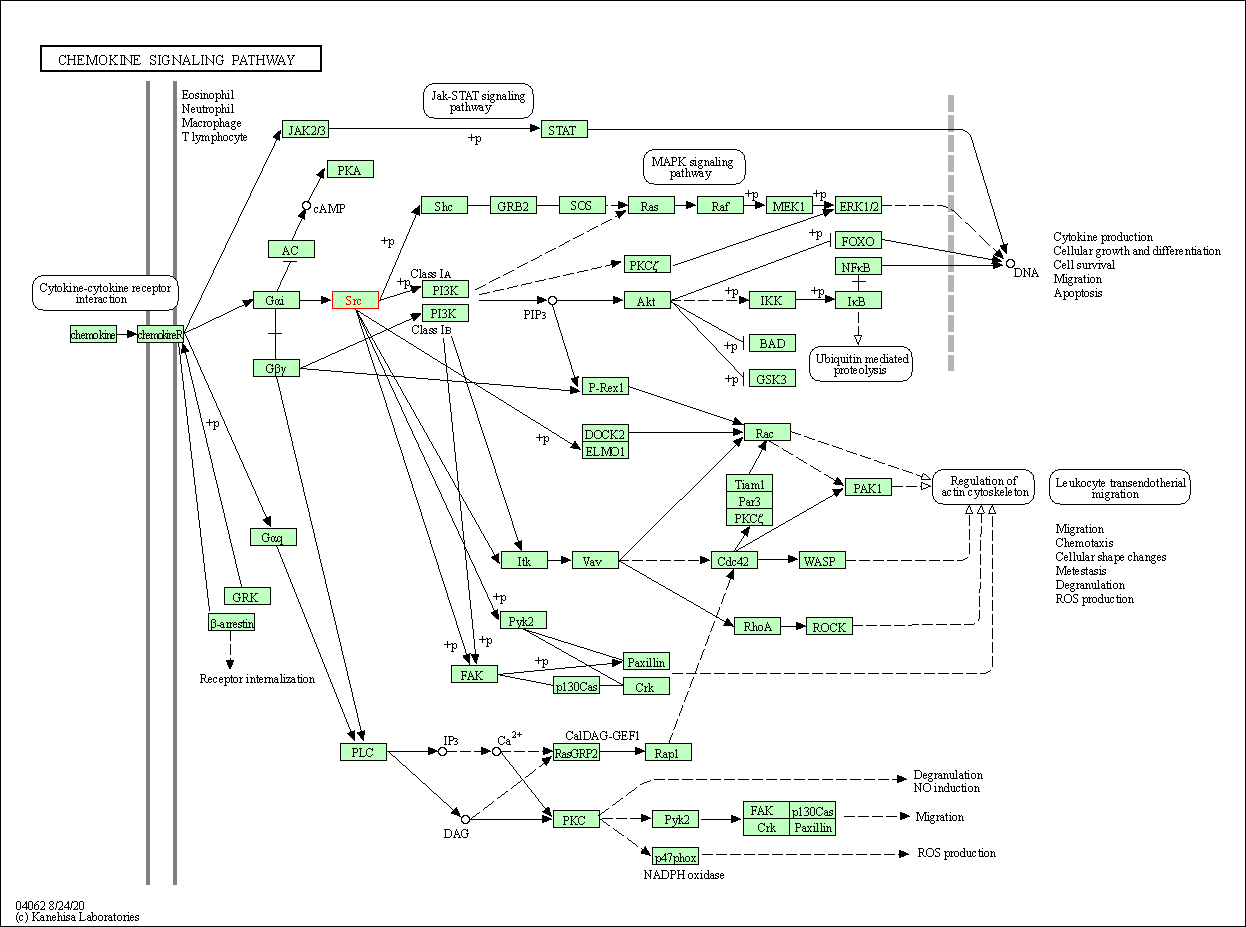
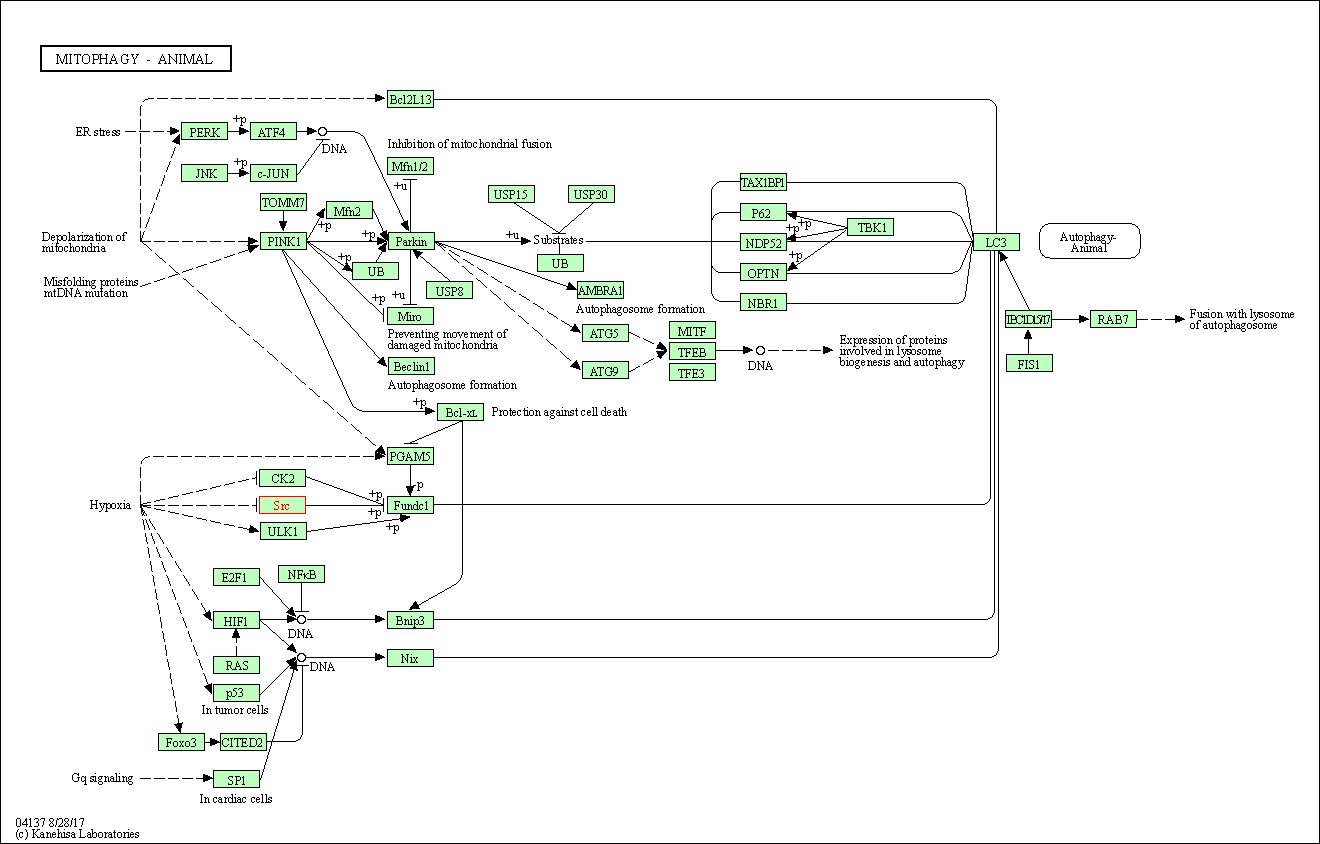
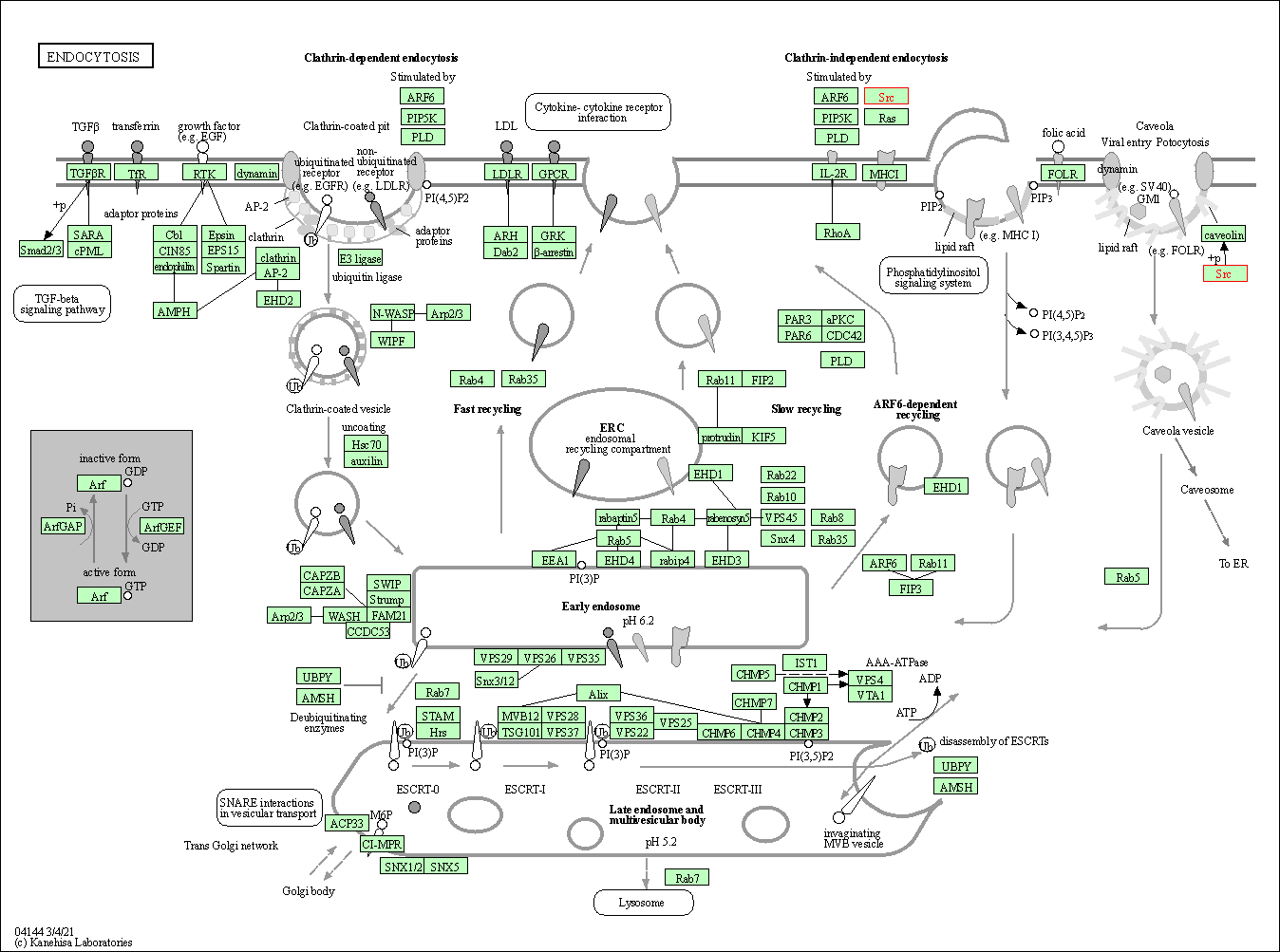


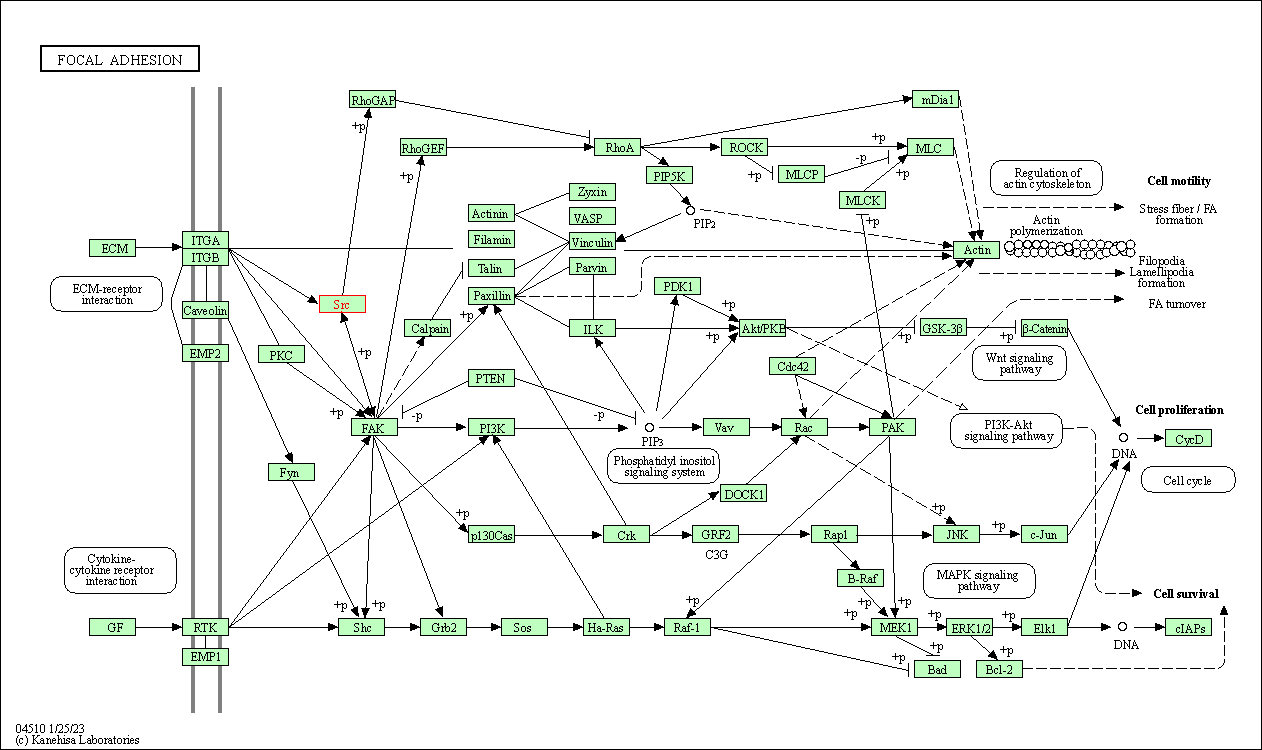
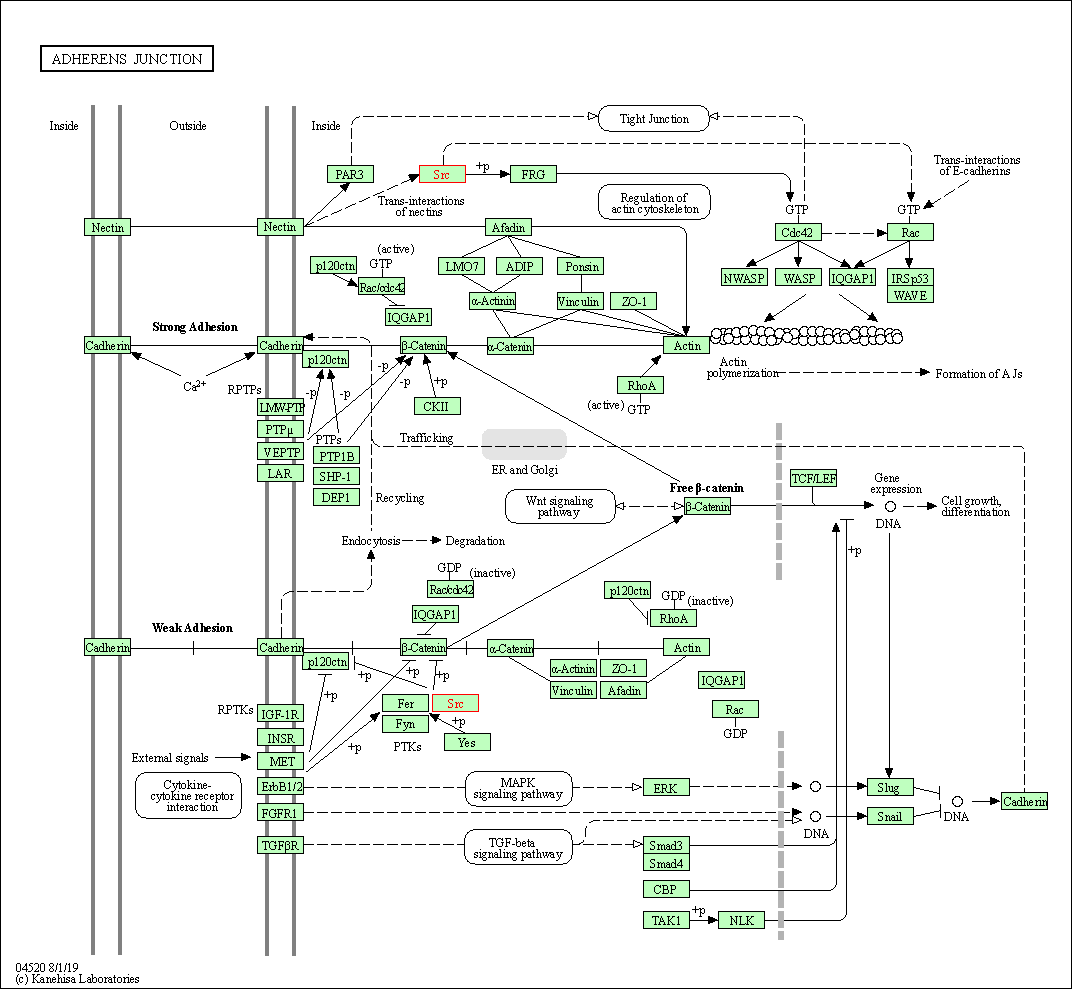
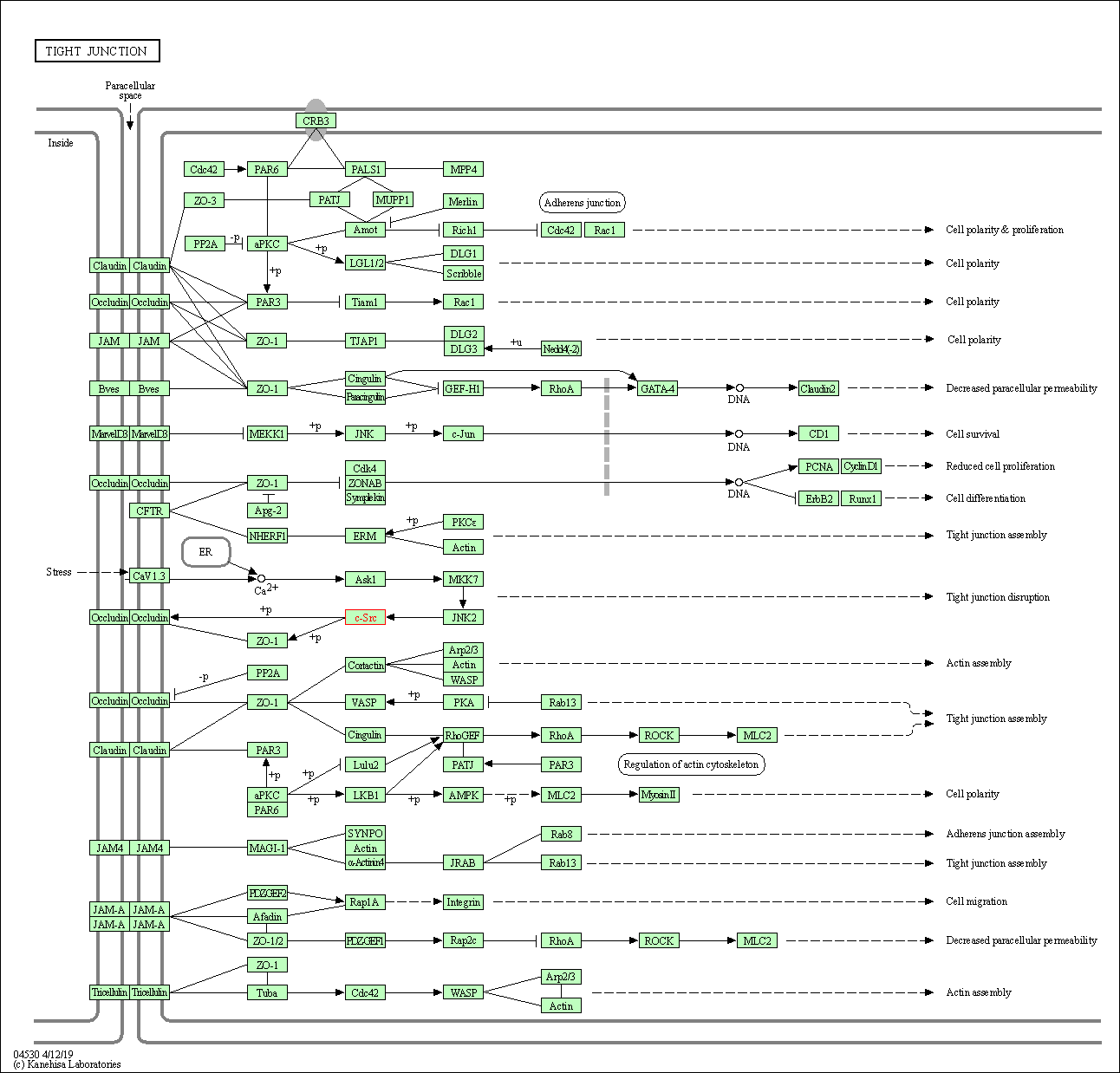
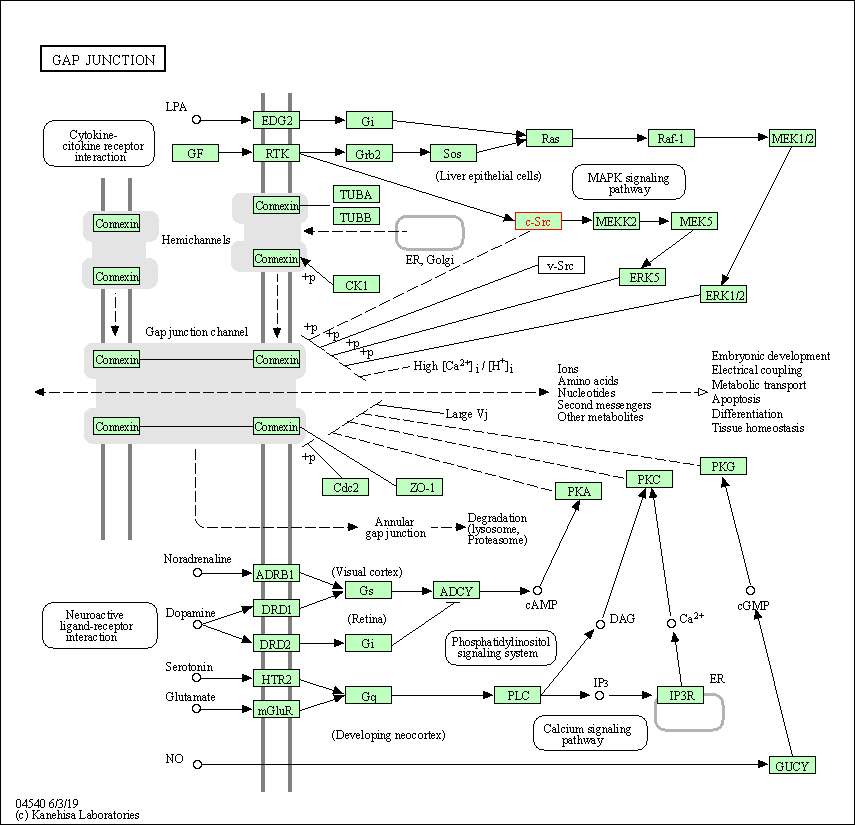
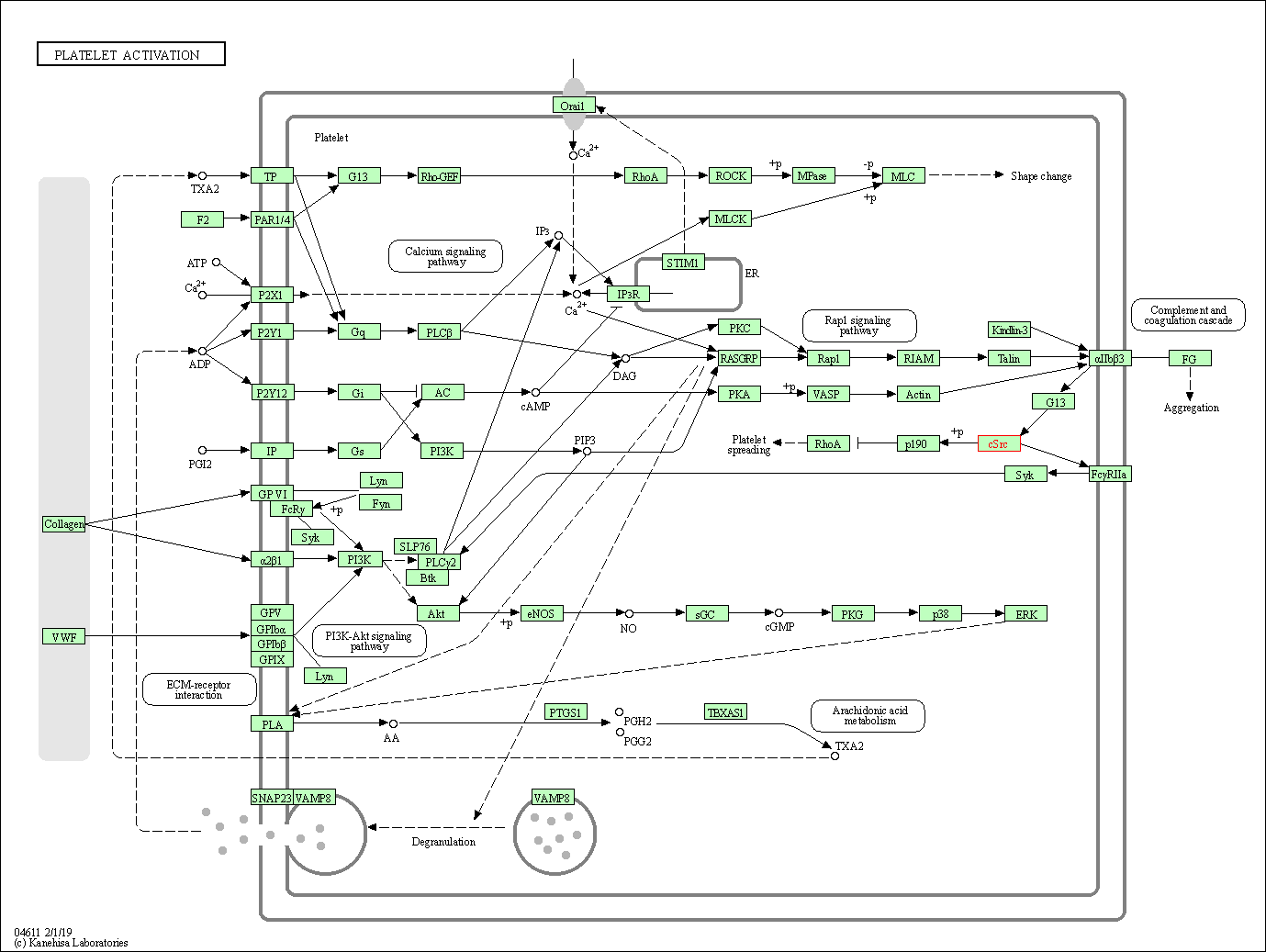
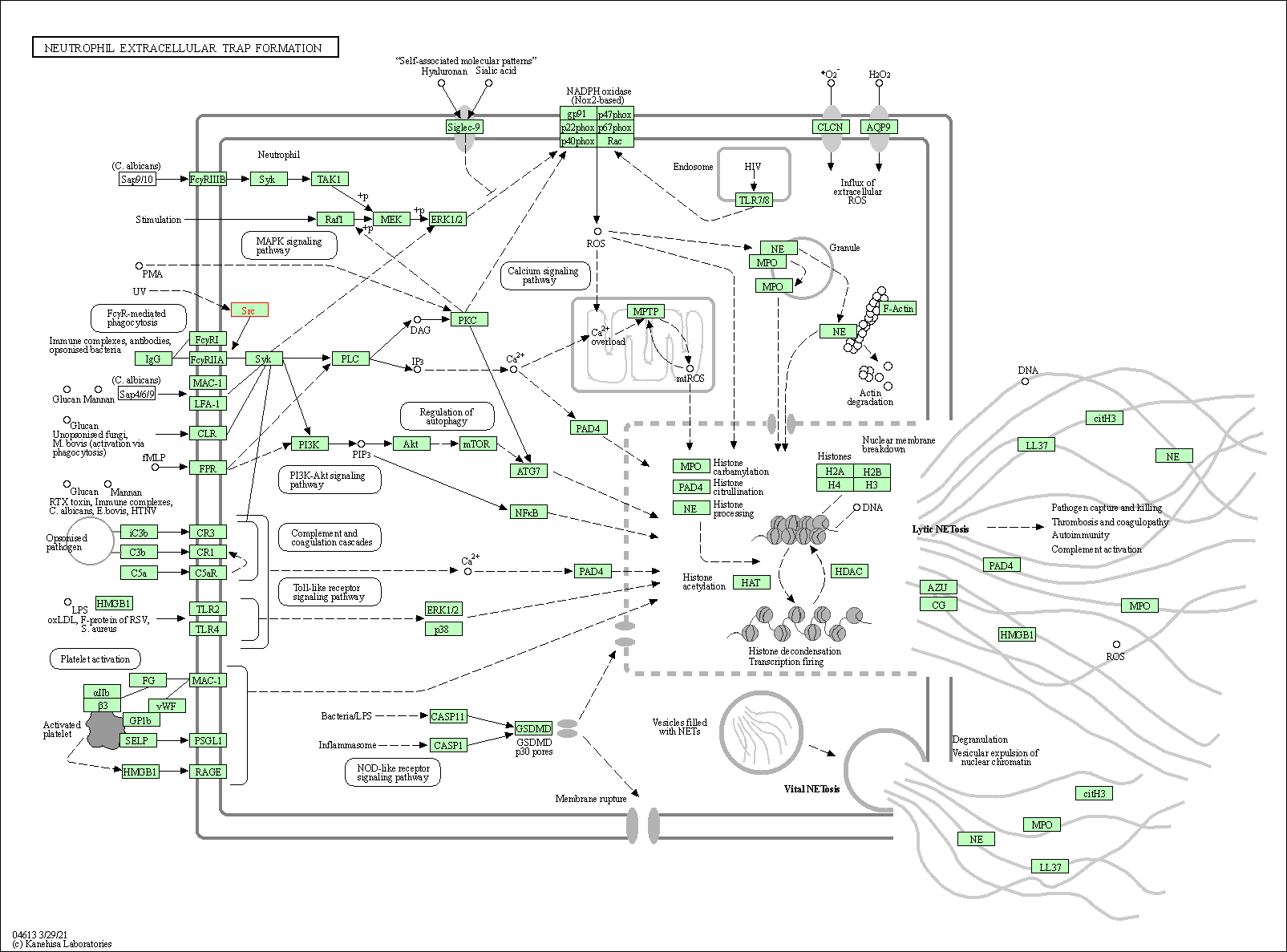



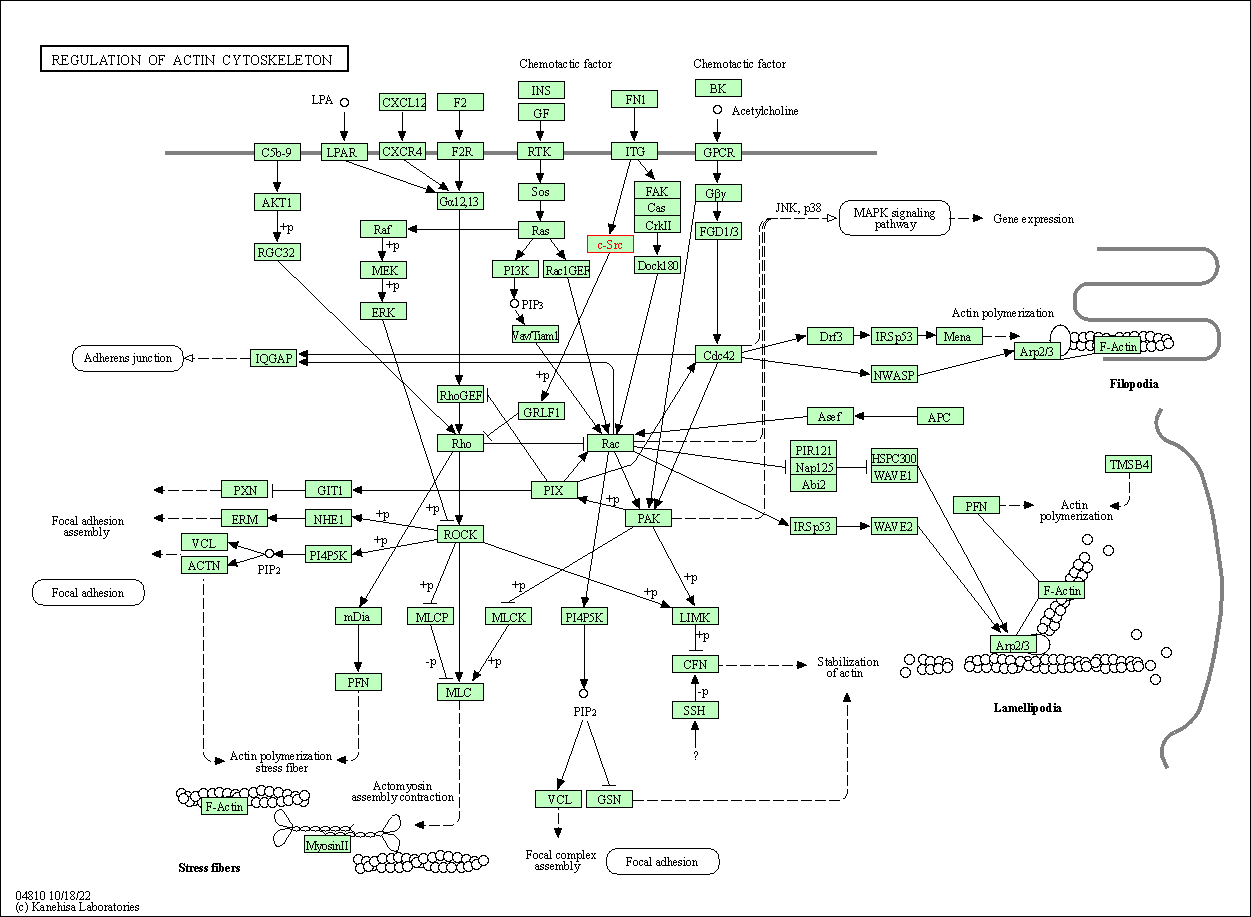
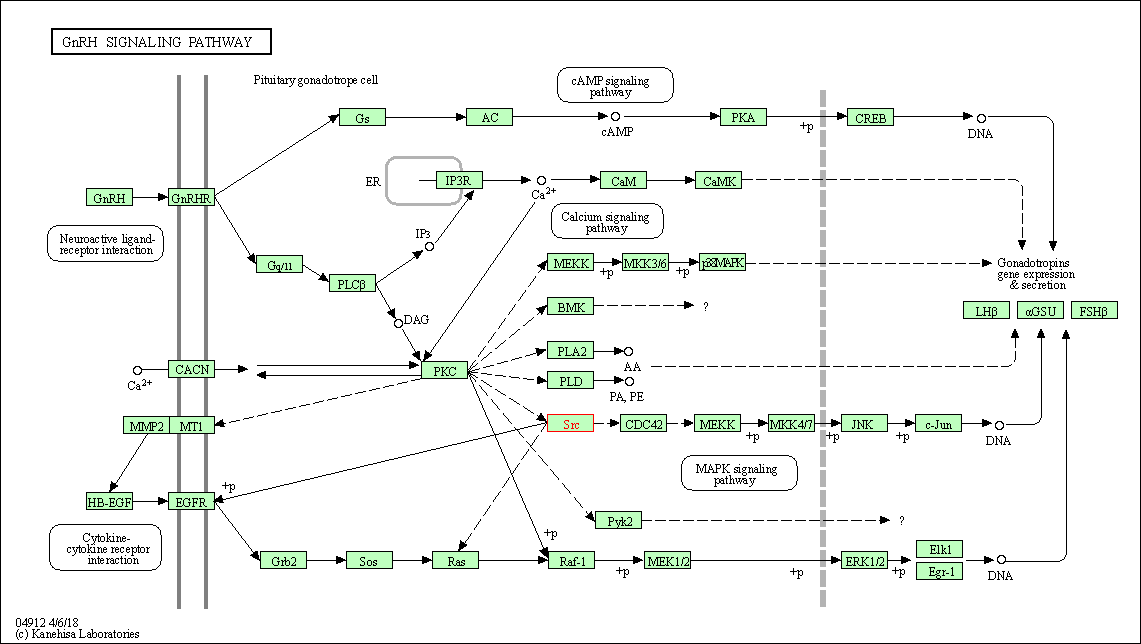


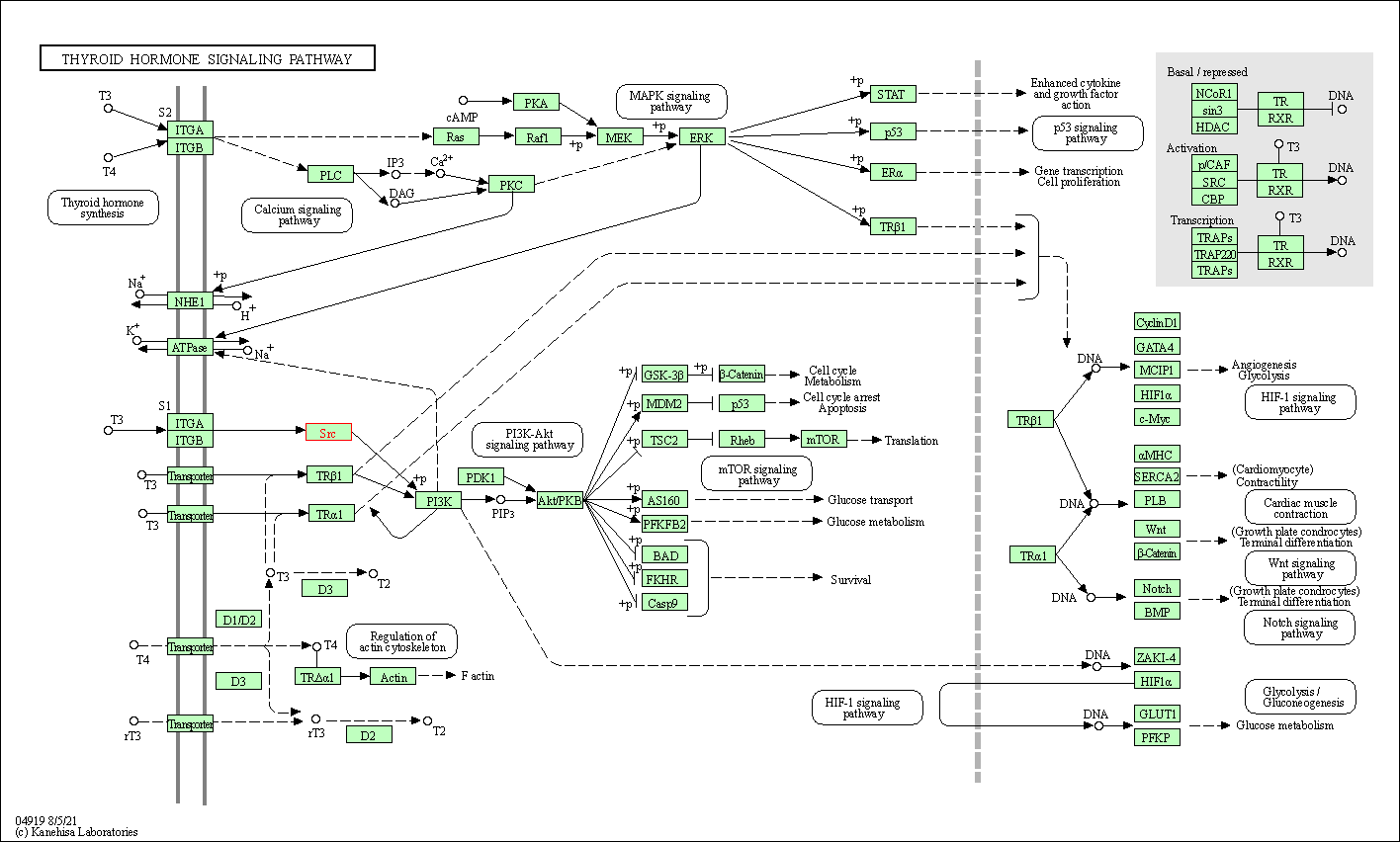
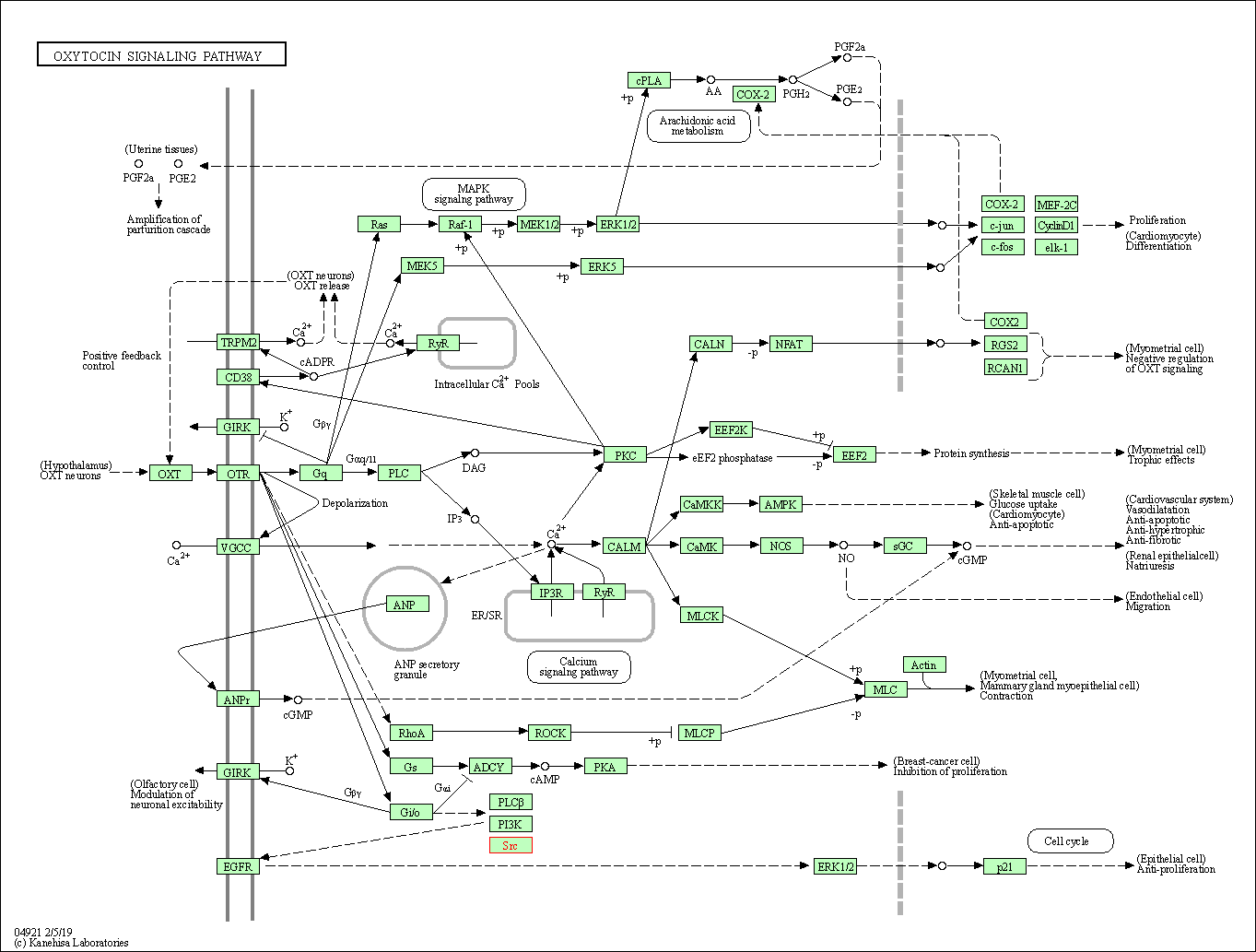

| KEGG Pathway | Pathway ID | Affiliated Target | Pathway Map |
|---|---|---|---|
| ErbB signaling pathway | hsa04012 | Affiliated Target |

|
| Class: Environmental Information Processing => Signal transduction | Pathway Hierarchy | ||
| Rap1 signaling pathway | hsa04015 | Affiliated Target |

|
| Class: Environmental Information Processing => Signal transduction | Pathway Hierarchy | ||
| Chemokine signaling pathway | hsa04062 | Affiliated Target |

|
| Class: Organismal Systems => Immune system | Pathway Hierarchy | ||
| Mitophagy - animal | hsa04137 | Affiliated Target |

|
| Class: Cellular Processes => Transport and catabolism | Pathway Hierarchy | ||
| Endocytosis | hsa04144 | Affiliated Target |

|
| Class: Cellular Processes => Transport and catabolism | Pathway Hierarchy | ||
| Axon guidance | hsa04360 | Affiliated Target |

|
| Class: Organismal Systems => Development and regeneration | Pathway Hierarchy | ||
| VEGF signaling pathway | hsa04370 | Affiliated Target |

|
| Class: Environmental Information Processing => Signal transduction | Pathway Hierarchy | ||
| Focal adhesion | hsa04510 | Affiliated Target |

|
| Class: Cellular Processes => Cellular community - eukaryotes | Pathway Hierarchy | ||
| Adherens junction | hsa04520 | Affiliated Target |

|
| Class: Cellular Processes => Cellular community - eukaryotes | Pathway Hierarchy | ||
| Tight junction | hsa04530 | Affiliated Target |

|
| Class: Cellular Processes => Cellular community - eukaryotes | Pathway Hierarchy | ||
| Gap junction | hsa04540 | Affiliated Target |

|
| Class: Cellular Processes => Cellular community - eukaryotes | Pathway Hierarchy | ||
| Platelet activation | hsa04611 | Affiliated Target |

|
| Class: Organismal Systems => Immune system | Pathway Hierarchy | ||
| Neutrophil extracellular trap formation | hsa04613 | Affiliated Target |

|
| Class: Organismal Systems => Immune system | Pathway Hierarchy | ||
| C-type lectin receptor signaling pathway | hsa04625 | Affiliated Target |

|
| Class: Organismal Systems => Immune system | Pathway Hierarchy | ||
| GABAergic synapse | hsa04727 | Affiliated Target |

|
| Class: Organismal Systems => Nervous system | Pathway Hierarchy | ||
| Inflammatory mediator regulation of TRP channels | hsa04750 | Affiliated Target |

|
| Class: Organismal Systems => Sensory system | Pathway Hierarchy | ||
| Regulation of actin cytoskeleton | hsa04810 | Affiliated Target |

|
| Class: Cellular Processes => Cell motility | Pathway Hierarchy | ||
| GnRH signaling pathway | hsa04912 | Affiliated Target |

|
| Class: Organismal Systems => Endocrine system | Pathway Hierarchy | ||
| Estrogen signaling pathway | hsa04915 | Affiliated Target |

|
| Class: Organismal Systems => Endocrine system | Pathway Hierarchy | ||
| Prolactin signaling pathway | hsa04917 | Affiliated Target |

|
| Class: Organismal Systems => Endocrine system | Pathway Hierarchy | ||
| Thyroid hormone signaling pathway | hsa04919 | Affiliated Target |

|
| Class: Organismal Systems => Endocrine system | Pathway Hierarchy | ||
| Oxytocin signaling pathway | hsa04921 | Affiliated Target |

|
| Class: Organismal Systems => Endocrine system | Pathway Hierarchy | ||
| Relaxin signaling pathway | hsa04926 | Affiliated Target |

|
| Class: Organismal Systems => Endocrine system | Pathway Hierarchy | ||
| Click to Show/Hide the Information of Affiliated Human Pathways | |||
| Degree | 162 | Degree centrality | 1.74E-02 | Betweenness centrality | 4.15E-02 |
|---|---|---|---|---|---|
| Closeness centrality | 2.91E-01 | Radiality | 1.49E+01 | Clustering coefficient | 7.58E-02 |
| Neighborhood connectivity | 3.73E+01 | Topological coefficient | 1.83E-02 | Eccentricity | 11 |
| Download | Click to Download the Full PPI Network of This Target | ||||
| Chemical Structure based Activity Landscape of Target | Top |
|---|---|
| Drug Property Profile of Target | Top | |
|---|---|---|
| (1) Molecular Weight (mw) based Drug Clustering | (2) Octanol/Water Partition Coefficient (xlogp) based Drug Clustering | |
|
|
||
| (3) Hydrogen Bond Donor Count (hbonddonor) based Drug Clustering | (4) Hydrogen Bond Acceptor Count (hbondacc) based Drug Clustering | |
|
|
||
| (5) Rotatable Bond Count (rotbonds) based Drug Clustering | (6) Topological Polar Surface Area (polararea) based Drug Clustering | |
|
|
||
| "RO5" indicates the cutoff set by lipinski's rule of five; "D123AB" colored in GREEN denotes the no violation of any cutoff in lipinski's rule of five; "D123AB" colored in PURPLE refers to the violation of only one cutoff in lipinski's rule of five; "D123AB" colored in BLACK represents the violation of more than one cutoffs in lipinski's rule of five | ||
| Co-Targets | Top | |||||
|---|---|---|---|---|---|---|
| Co-Targets | ||||||
| Target Poor or Non Binders | Top | |||||
|---|---|---|---|---|---|---|
| Target Poor or Non Binders | ||||||
| Target Regulators | Top | |||||
|---|---|---|---|---|---|---|
| Target-regulating microRNAs | ||||||
| Target-interacting Proteins | ||||||
| Target Profiles in Patients | Top | |||||
|---|---|---|---|---|---|---|
| Target Expression Profile (TEP) |
||||||
| Target-Related Models and Studies | Top | |||||
|---|---|---|---|---|---|---|
| Target Validation | ||||||
| Target QSAR Model | ||||||
| References | Top | |||||
|---|---|---|---|---|---|---|
| REF 1 | In vivo antitumor activity of herbimycin A, a tyrosine kinase inhibitor, targeted against BCR/ABL oncoprotein in mice bearing BCR/ABL-transfected cells. Leuk Res. 1994 Nov;18(11):867-73. | |||||
| REF 2 | URL: http://www.guidetopharmacology.org Nucleic Acids Res. 2015 Oct 12. pii: gkv1037. The IUPHAR/BPS Guide to PHARMACOLOGY in 2016: towards curated quantitative interactions between 1300 protein targets and 6000 ligands. (Ligand id: 5710). | |||||
| REF 3 | ClinicalTrials.gov (NCT02311998) Phase I/II Study of Bosutinib in Combination With Inotuzumab Ozogamicin in CD22-positive Philadelphia-Chromosome (PC) Positive Acute Lymphoblastic Leukemia (ALL) and Chronic Myeloid Leukemia (CML). U.S. National Institutes of Health. | |||||
| REF 4 | URL: http://www.guidetopharmacology.org Nucleic Acids Res. 2015 Oct 12. pii: gkv1037. The IUPHAR/BPS Guide to PHARMACOLOGY in 2016: towards curated quantitative interactions between 1300 protein targets and 6000 ligands. (Ligand id: 5678). | |||||
| REF 5 | 2006 drug approvals: finding the niche. Nat Rev Drug Discov. 2007 Feb;6(2):99-101. | |||||
| REF 6 | Dasatinib: a tyrosine kinase inhibitor for the treatment of chronic myelogenous leukemia and philadelphia chromosome-positive acute lymphoblastic leukemia. Clin Ther. 2007 Nov;29(11):2289-308. | |||||
| REF 7 | Drugs@FDA. U.S. Food and Drug Administration. U.S. Department of Health & Human Services. 2015 | |||||
| REF 8 | URL: http://www.guidetopharmacology.org Nucleic Acids Res. 2015 Oct 12. pii: gkv1037. The IUPHAR/BPS Guide to PHARMACOLOGY in 2016: towards curated quantitative interactions between 1300 protein targets and 6000 ligands. (Ligand id: 5984). | |||||
| REF 9 | Nat Rev Drug Discov. 2013 Feb;12(2):87-90. | |||||
| REF 10 | Clinical pipeline report, company report or official report of the Pharmaceutical Research and Manufacturers of America (PhRMA) | |||||
| REF 11 | URL: http://www.guidetopharmacology.org Nucleic Acids Res. 2015 Oct 12. pii: gkv1037. The IUPHAR/BPS Guide to PHARMACOLOGY in 2016: towards curated quantitative interactions between 1300 protein targets and 6000 ligands. (Ligand id: 7882). | |||||
| REF 12 | Trusted, scientifically sound profiles of drug programs, clinical trials, safety reports, and company deals, written by scientists. Springer. 2015. Adis Insight (drug id 800015430) | |||||
| REF 13 | Clinical pipeline report, company report or official report of the Pharmaceutical Research and Manufacturers of America (PhRMA) | |||||
| REF 14 | Clinical pipeline report, company report or official report of the Pharmaceutical Research and Manufacturers of America (PhRMA) | |||||
| REF 15 | URL: http://www.guidetopharmacology.org Nucleic Acids Res. 2015 Oct 12. pii: gkv1037. The IUPHAR/BPS Guide to PHARMACOLOGY in 2016: towards curated quantitative interactions between 1300 protein targets and 6000 ligands. (Ligand id: 7731). | |||||
| REF 16 | Current and future treatments of bone metastases. Expert Opin Emerg Drugs. 2008 Dec;13(4):609-27. | |||||
| REF 17 | ClinicalTrials.gov (NCT04161391) Study of TPX-0046, A RET/SRC Inhibitor in Adult Subjects With Advanced Solid Tumors Harboring RET Fusions or Mutations. U.S. National Institutes of Health. | |||||
| REF 18 | Clinical pipeline report, company report or official report of ISIS Pharmaceuticals (2011). | |||||
| REF 19 | Trusted, scientifically sound profiles of drug programs, clinical trials, safety reports, and company deals, written by scientists. Springer. 2015. Adis Insight (drug id 800041844) | |||||
| REF 20 | ClinicalTrials.gov (NCT04759807) A Phase 1b 3-way Crossover Study to Assess the Safety, Tolerability and Pharmacokinetics of Repeated Once Daily Doses of PUR1800 in Adult Patients With Stable Chronic Obstructive Pulmonary Disease. U.S.National Institutes of Health. | |||||
| REF 21 | ClinicalTrials.gov (NCT03993873) Phase 1 Study of TPX-0022, a MET/CSF1R/SRC Inhibitor, in Patients With Advanced Solid Tumors Harboring Genetic Alterations in MET. U.S. National Institutes of Health. | |||||
| REF 22 | Trusted, scientifically sound profiles of drug programs, clinical trials, safety reports, and company deals, written by scientists. Springer. 2015. Adis Insight (drug id 800010691) | |||||
| REF 23 | A comparison of physicochemical property profiles of marketed oral drugs and orally bioavailable anti-cancer protein kinase inhibitors in clinical development. Curr Top Med Chem. 2007;7(14):1408-22. | |||||
| REF 24 | In vitro and clinical investigation of the relationship between CCR5 receptor occupancy and anti-HIV activity of Aplaviroc. J Clin Pharmacol. 2008 Oct;48(10):1179-88. | |||||
| REF 25 | Multi-target therapeutics: when the whole is greater than the sum of the parts. Drug Discov Today. 2007 Jan;12(1-2):34-42. | |||||
| REF 26 | Synthesis and Src kinase inhibitory activity of a series of 4-[(2,4-dichloro-5-methoxyphenyl)amino]-7-furyl-3-quinolinecarbonitriles. J Med Chem. 2006 Dec 28;49(26):7868-76. | |||||
| REF 27 | Clinical pipeline report, company report or official report of the Pharmaceutical Research and Manufacturers of America (PhRMA) | |||||
| REF 28 | Novel dual Src/Abl inhibitors for hematologic and solid malignancies.Expert Opin Investig Drugs.2010 Aug;19(8):931-45. | |||||
| REF 29 | Clinical pipeline report, company report or official report of Turning Point Therapeutics. | |||||
| REF 30 | The selectivity of protein kinase inhibitors: a further update. Biochem J. 2007 Dec 15;408(3):297-315. | |||||
| REF 31 | URL: http://www.guidetopharmacology.org Nucleic Acids Res. 2015 Oct 12. pii: gkv1037. The IUPHAR/BPS Guide to PHARMACOLOGY in 2016: towards curated quantitative interactions between 1300 protein targets and 6000 ligands. (Target id: 2206). | |||||
| REF 32 | Clinical pipeline report, company report or official report of Pulmatrix Lexington, MA | |||||
| REF 33 | Clinical pipeline report, company report or official report of the Pharmaceutical Research and Manufacturers of America (PhRMA) | |||||
| REF 34 | Clinical pipeline report, company report or official report of Turning Point Therapeutics. | |||||
| REF 35 | A STAT inhibitor patent review: progress since 2011.Expert Opin Ther Pat. 2015;25(12):1397-421. | |||||
| REF 36 | Bcr-Abl tyrosine kinase inhibitors: a patent review.Expert Opin Ther Pat. 2015 Apr;25(4):397-412. | |||||
| REF 37 | Cancer stem cell (CSC) inhibitors: a review of recent patents (2012-2015).Expert Opin Ther Pat. 2017 Jul;27(7):753-761. | |||||
| REF 38 | RET kinase inhibitors: a review of recent patents (2012-2015).Expert Opin Ther Pat. 2017 Jan;27(1):91-99. | |||||
| REF 39 | Structure-based design of an osteoclast-selective, nonpeptide src homology 2 inhibitor with in vivo antiresorptive activity. Proc Natl Acad Sci U S A. 2000 Aug 15;97(17):9373-8. | |||||
| REF 40 | Anti-angiogenic activity of selected receptor tyrosine kinase inhibitors, PD166285 and PD173074: implications for combination treatment with photodynamic therapy. Invest New Drugs. 1999;17(2):121-35. | |||||
| REF 41 | The Protein Data Bank. Nucleic Acids Res. 2000 Jan 1;28(1):235-42. | |||||
| REF 42 | Discovery and preliminary structure-activity relationship studies of novel benzotriazine based compounds as Src inhibitors. Bioorg Med Chem Lett. 2006 Nov 1;16(21):5546-50. | |||||
| REF 43 | Substituted 5,7-diphenyl-pyrrolo[2,3d]pyrimidines: potent inhibitors of the tyrosine kinase c-Src. Bioorg Med Chem Lett. 2000 May 1;10(9):945-9. | |||||
| REF 44 | A-420983: a potent, orally active inhibitor of lck with efficacy in a model of transplant rejection. Bioorg Med Chem Lett. 2004 May 17;14(10):2613-6. | |||||
| REF 45 | Discovery of A-770041, a src-family selective orally active lck inhibitor that prevents organ allograft rejection. Bioorg Med Chem Lett. 2006 Jan 1;16(1):118-22. | |||||
| REF 46 | Synthesis and structure-activity relationships of linear and conformationally constrained peptide analogues of CIYKYY as Src tyrosine kinase inhibi... J Med Chem. 2006 Jun 1;49(11):3395-401. | |||||
| REF 47 | 9-(Arenethenyl)purines as dual Src/Abl kinase inhibitors targeting the inactive conformation: design, synthesis, and biological evaluation. J Med Chem. 2009 Aug 13;52(15):4743-56. | |||||
| REF 48 | A combination of docking/dynamics simulations and pharmacophoric modeling to discover new dual c-Src/Abl kinase inhibitors. J Med Chem. 2006 Jun 1;49(11):3278-86. | |||||
| REF 49 | Discovery and SAR of 1,3,4-thiadiazole derivatives as potent Abl tyrosine kinase inhibitors and cytodifferentiating agents. Bioorg Med Chem Lett. 2008 Feb 1;18(3):1207-11. | |||||
| REF 50 | Synthesis and c-Src inhibitory activity of imidazo[1,5-a]pyrazine derivatives as an agent for treatment of acute ischemic stroke. Bioorg Med Chem. 2007 Jan 15;15(2):868-85. | |||||
| REF 51 | A novel inhibitor of the tyrosine kinase Src suppresses phosphorylation of its major cellular substrates and reduces bone resorption in vitro and in rodent models in vivo. Bone. 1999 May;24(5):437-49. | |||||
| REF 52 | DrugBank 3.0: a comprehensive resource for 'omics' research on drugs. Nucleic Acids Res. 2011 Jan;39(Database issue):D1035-41. | |||||
| REF 53 | The Role of 4-phosphonodifluoromethyl- and 4-phosphono-phenylalanine in the selectivity and cellular uptake of SH2 domain ligands, Bioorg. Med. Chem. Lett. 7(14):1909-1914 (1997). | |||||
| REF 54 | Biochemical and cellular effects of c-Src kinase-selective pyrido[2, 3-d]pyrimidine tyrosine kinase inhibitors. Biochem Pharmacol. 2000 Oct 1;60(7):885-98. | |||||
| REF 55 | (6,7-Dimethoxy-2,4-dihydroindeno[1,2-c]pyrazol-3-yl)phenylamines: platelet-derived growth factor receptor tyrosine kinase inhibitors with broad ant... J Med Chem. 2005 Dec 29;48(26):8163-73. | |||||
| REF 56 | The discovery of the potent aurora inhibitor MK-0457 (VX-680). Bioorg Med Chem Lett. 2009 Jul 1;19(13):3586-92. | |||||
| REF 57 | How many drug targets are there Nat Rev Drug Discov. 2006 Dec;5(12):993-6. | |||||
| REF 58 | Discovery of type II inhibitors of TGFbeta-activated kinase 1 (TAK1) and mitogen-activated protein kinase kinase kinase kinase 2 (MAP4K2). J Med Chem. 2015 Jan 8;58(1):183-96. | |||||
| REF 59 | Structure-activity relationships of 6-(2,6-dichlorophenyl)-8-methyl-2-(phenylamino)pyrido[2,3-d]pyrimidin-7-ones: toward selective Abl inhibitors. Bioorg Med Chem Lett. 2009 Dec 15;19(24):6872-6. | |||||
| REF 60 | Hybrid compound design to overcome the gatekeeper T338M mutation in cSrc. J Med Chem. 2009 Jul 9;52(13):3915-26. | |||||
| REF 61 | Discovery of novel 2-(aminoheteroaryl)-thiazole-5-carboxamides as potent and orally active Src-family kinase p56(Lck) inhibitors. Bioorg Med Chem Lett. 2004 Dec 20;14(24):6061-6. | |||||
| REF 62 | The design, synthesis, and biological evaluation of potent receptor tyrosine kinase inhibitors. Bioorg Med Chem Lett. 2012 Aug 1;22(15):4979-85. | |||||
| REF 63 | Targeted polypharmacology: discovery of dual inhibitors of tyrosine and phosphoinositide kinases. Nat Chem Biol. 2008 Nov;4(11):691-9. | |||||
| REF 64 | Synthesis and pharmacological evaluation of novel beta-nitrostyrene derivatives as tyrosine kinase inhibitors with potent antiplatelet activity. Biochem Pharmacol. 2007 Aug 15;74(4):601-11. | |||||
| REF 65 | Inhibition of Src kinase activity by 7-ethynyl-4-phenylamino-3-quinolinecarbonitriles: identification of SKS-927. Bioorg Med Chem Lett. 2007 Mar 1;17(5):1358-61. | |||||
| REF 66 | Discovery of [7-(2,6-dichlorophenyl)-5-methylbenzo [1,2,4]triazin-3-yl]-[4-(2-pyrrolidin-1-ylethoxy)phenyl]amine--a potent, orally active Src kinas... Bioorg Med Chem Lett. 2007 Feb 1;17(3):602-8. | |||||
| REF 67 | Novel 2-aminopyrimidine carbamates as potent and orally active inhibitors of Lck: synthesis, SAR, and in vivo antiinflammatory activity. J Med Chem. 2006 Aug 10;49(16):4981-91. | |||||
| REF 68 | Discovery of a novel series of potent and selective substrate-based inhibitors of p60c-src protein tyrosine kinase: conformational and topographica... J Med Chem. 1998 Jun 18;41(13):2252-60. | |||||
| REF 69 | Src Kinase Domain in complex with ponatinib | |||||
| REF 70 | A conserved water-mediated hydrogen bond network defines bosutinib's kinase selectivity. Nat Chem Biol. 2014 Feb;10(2):127-32. | |||||
If You Find Any Error in Data or Bug in Web Service, Please Kindly Report It to Dr. Zhou and Dr. Zhang.

